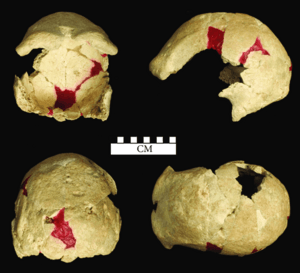WLH-50 facts for kids
Fossil WLH-50 is a part of a human skull that was found in 1982. It was discovered in the Willandra Lakes Region of Australia and put back together by a scientist named Alan Thorne. Scientists are still trying to figure out the exact age of this fossil. There is also a discussion about how it is related to other early humans from the late Pleistocene period (which was part of the Ice Age), especially those found in a place called Ngandong, because they look quite similar.
Contents
What Makes WLH-50 Special?
Scientists say that WLH-50 shares many features with Homo erectus, an ancient human species. But WLH-50 also has some unique characteristics that stand out:
- It has a very thick brow ridge above the eyes.
- The top part of its skull (called the cranial vault) is unusually thick and strong, about 15–19 millimeters thick. Some scientists think this might have been an adaptation to protect against diseases like Malaria.
- Its brain size was quite large, around 1590 cubic centimeters.
- It has an extended area at the back of the neck for strong muscle attachment.
- There's a bump at the back of the skull, known as an Occipital bun.
- Overall, it was a very strong and large skull.
How Do Scientists Figure Out Its Age?
The WLH-50 fossil was found in a lake area that often dries up. When the lake dries and fills again, it can move the soil and layers of rock around. This makes it really hard to know the exact age of the fossil. Scientists have tried different methods to date WLH-50:
Using Radiocarbon Dating
In the early 1980s, scientists at the Australian National University used Radiocarbon dating to test materials found with the fossil.
- They tested a hard, crusty layer (called carbonate) on the bone. This test suggested the fossil was about 9,500 to 11,100 years old.
- They also tested a freshwater shell found nearby. This shell was dated to be about 16,500 to 18,000 years old.
Using Electromagnetic Spin Resonance (ESR)
In 1987, another dating method called ESR was used. This technique estimated the bone fragment to be around 29,000 years old, give or take 5,000 years.
Using Spectrometry
In 1998, scientists Simpson and Grun used advanced techniques like gamma spectroscopy and Uranium-series dating. They suggested that the fossil might be around 14,000 years old. However, they also noted that this method might only give a minimum age. This is because uranium starts to build up in the bone only after it has been buried.
Different Ideas About Human Ancestry
There's a big discussion in the field of paleoanthropology (the study of ancient humans) about whether the Ngandong early humans should be considered Homo sapiens (modern humans).
The Replacement Theory
This idea suggests that modern humans (like WLH-50) came out of Africa. It predicts that early humans from Africa and the Levant (a region in the Middle East) are direct ancestors of WLH-50. According to this theory, the Ngandong early humans are not direct ancestors of WLH-50.
The Multi-Regional Model
This idea suggests that modern humans developed in different parts of the world at the same time. It considers early humans from Africa, the Levant, and Ngandong as possible ancestors to WLH-50. This model would mean that the Ngandong early humans are also a type of Homo sapiens.


